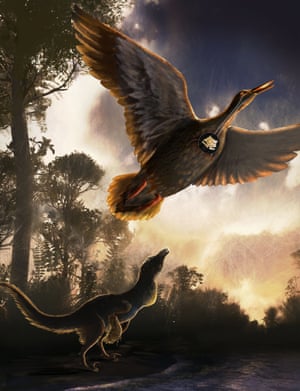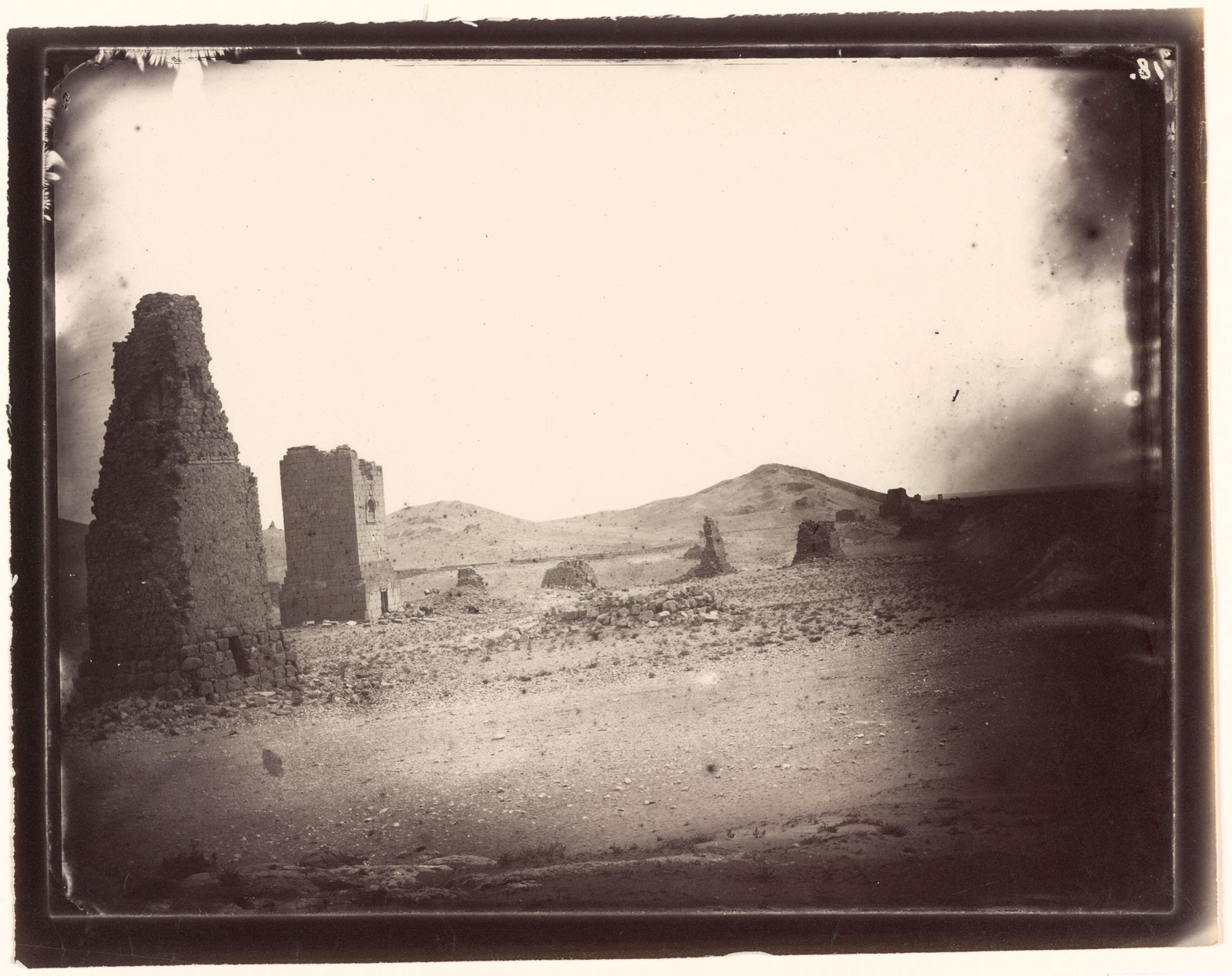via The Guardian by Nicola Davis
66m-year-old syrinx of Vegavis iaai suggests that creature could honk and quack and confirms some modern bird groups lived alongside the dinosaurs

A mid-sized raptor dinosaur is shown using close-mouth vocal behaviour and Vegavis iaai, whose fossilised voicebox has been found, is shown flying overhead. Illustration: Nicole Fuller/Sayo Art for UT Austin
The oldest evidence of a bird’s voice box has been found among the fossilised remains of a duck-like creature that lived more than 66 million years ago.
The discovery suggests that the animal was able to make a variety of sounds similar to those of current day ducks, including quacks.
The human voice box, or larynx, sits near the top of the windpipe. However, the vocal organ of birds - known as a syrinx - lies deep within the chest near the heart, where the windpipe branches to the lungs. Composed of cartilage rings and soft tissue, it allows birds to make a wide variety of calls, from songs to honks.
But little is known about the origin of the organ.
Continue reading
===================================
via Boing Boing by Andrea Jame
Luke Towan makes a lot of gorgeous model railroad items, but his tutorial on making tiny trees using wire, latex, glue, and paint is especially cool to watch from start to finish.
Continue reading and then watch the video.
===================================
via OUP Blog by Maria Rosa Antognazza

At the turn of the seventeenth and eighteenth centuries, national states were on the rise. Versailles was constructed as a stage on which the Sun King, Louis XIV, acted out the pageant of absolute sovereignty, while his armies annexed neighbouring territories for the greater glory of France. At the death of Charles II of Spain in November 1700, the Spanish throne and its extensive possessions in Italy, the Low Countries, and the New World passed to his grandson, Philip, Duke of Anjou. To the east and south, the Ottoman Empire, which already controlled most of the Balkans, Greece, Turkey, the Middle East, and North Africa, once again threatened Vienna. To the north, Sweden consolidated its empire on the shores of the Baltic while the union of the crowns of England and Scotland in 1707 under Queen Anne established Great Britain as a single kingdom.
Continue reading
===================================
A long-running investigation of exceptional children reveals what it takes to produce the scientists who will lead the twenty-first century.
via Arts & Letters Daily: Tom Clynes in Nature
On a summer day in 1968, professor Julian Stanley met a brilliant but bored 12-year-old named Joseph Bates. The Baltimore student was so far ahead of his classmates in mathematics that his parents had arranged for him to take a computer-science course at Johns Hopkins University, where Stanley taught. Even that wasn't enough. Having leapfrogged ahead of the adults in the class, the child kept himself busy by teaching the FORTRAN programming language to graduate students.
Continue reading
===================================
via The Guardian by John Walsh

Stripped-back simplicity … the new-look Penguin Pocket Classics. Photograph: Penguin Books
Imagine you have a sudden burning desire to read David Copperfield, Charles Dickens’s favourite of all his novels. Thanks to Project Gutenberg, you could read it for nothing online but, correctly reasoning that it would be tedious to scroll through 600 pages on a screen, you go to a bookshop. There you find that David Copperfield is available as an Everyman Classic hardback, a Penguin Classic paperback, an Oxford University Press paperback and a Vintage Classic paperback, all designed in pleasing formats, heftily branded and with paintings or artful imagery on their covers, along with introductory essays by university professors, a chronology of Dickens’s life and a scholarly trove of explanatory notes.
Continue reading
I get stopped on the first line. I am not a fan of Mr Dickens's writing. Should I be ashamed? I am not.
===================================
via Boing Boing by Jason Weisburger

Perfect for the kid of someone you don't like very much is a Rock Tumbler.
Continue reading
===================================
via Arts & Letters Daily: Tina Brown in New York Times Book Review

The Mitford sisters (and, second from left, brother) in Oxfordshire, 1935.The Illustrated London News Picture Library, London, UK, via Bridgeman Images
Oh no! Not another book about the Mitfords! That was my instant reaction when Laura Thompson’s “The Six,” a group biography of the notorious sisters, all half-dozen of them, landed on my desk. …
How wrong I was. “The Six” is riveting. It captures all the wayward magnetism and levity that have enchanted countless writers without neglecting the tragic darkness of many of the sisters’ life choices and the savage sociopolitical currents that fuelled them.
Continue reading
===================================
via 3 Quarks Daily: Ingrid D. Rowland at the NY Review of Books

Valley of the Tombs, Palmyra
In September 2015, the Getty Research Institute in Los Angeles acquired the first photographs ever taken of Palmyra, the great trading oasis in the heart of the Syrian desert. Louis Vignes was a young lieutenant in the French navy whose interest in photography earned him a place on a scientific expedition to the Dead Sea region in 1863. The twenty-nine photographs he made of Palmyra during his visit in 1864 (including two panoramic shots) were finally printed in Paris by the pioneering photographer Charles Nègre (who had taught Vignes) between 1865 and 1867.
Continue reading
===================================
via Boing Boing by Andrea James
A paper published this summer looked into over 100 times humpbacks were observed disrupting orcas who are hunting, like these humpbacks trying to save a grey whale and calf. But why do they do it?
Scientists propose the whales either mob like this to save a fellow humpback then stick around to help whatever is being hunted, or they just hate orcas and love their fellow sea friends, formally known as “interspecies altruism”.
Continue reading and view video
===================================
via OUP Blog by Richard Sowerby

Government advisers don’t regularly admit to handling doctored evidence. The extent to which the actions of recent governments may have depended on documents which had been ‘sexed up’ have – quite rightly – become matters for close scrutiny in recent decades. But the modern world has no monopoly over the spurious, the doubtful, and the falsified. Over one thousand years ago, a curious pamphlet arrived at the palace of the Frankish emperor, Louis the Pious (r. 814–840). It claimed to contain a complete and infallible report of the state of Louis’ kingdom. Along with it came a story that seems to epitomize all our stereotypes about the credulity of the Middle Ages. The pamphlet addressed to the emperor was in fact a message from heaven.
Continue reading
No comments:
Post a Comment